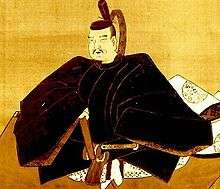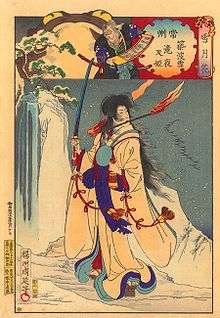Taira no Masakado

Taira no Masakado (平 将門, died in the second lunar month of 940) was a samurai in the Heian period of Japan, who led a rebellion against the central government of Kyoto.[1]
History
Masakado was born into a prominent noble lineage, the Kanmu Heishi (or Taira clan descended from Emperor Kanmu). He served the imperial court in the capital as a youth, and then settled down to the life of a country gentleman in the provinces of eastern Japan, to the northeast of modern-day Tokyo.
His career is detailed in Shōmonki ("The Masakado Chronicle"), a literary account of his life believed to have been completed as early as the 940s (although the earliest surviving copy dates from 1099)[2] by an anonymous author.
The Taira Masakado Insurrection of 939-940 (known in Japanese as Jōhei - Tengyō no ran, after the calendar eras in which it occurred) ranks among the most dramatic episodes in the early history of the samurai. Coinciding with earthquakes, rainbows and lunar eclipses in the capital; uprisings in the north; and pirate disturbances in the west; it threw the court and the capital into a panic, and climaxed, according to most versions of the story, with the protagonist’s claiming for himself the title, “New Emperor.” Many historians have perceived the incident as an early harbinger of the late twelfth-, thirteenth- and fourteenth-century events that, step by step, ushered in the medieval era of warrior rule.
The drama began in the second month of 935, when Masakado was suddenly attacked—ambushed—by another prominent local warrior, Minamoto Tasuku (dates unknown), at a place called Nomoto, near the convergence of Hitachi, Shimozuke, Musashi, and Shimōsa provinces. Tasuku was the eldest son of Minamoto Mamoru, a powerful warrior and sometime government official of Hitachi. The reason for his grudge against Masakado is unclear, but his decision to pursue it in the field set in motion a complex and momentous chain of events. Within months Masakado found himself at war with several of his relatives. Although taken by surprise, Masakado defeated Tasuku, and then struck back, burning and plundering the homes and property of Tasuku’s supporters across southeastern Hitachi, and slaughtering thousands of the residents of these compounds. Among the most important victims of the Nomoto battle and its brutal sequel were Tasuku, his brothers, and his brother-in-law, Taira Kunika (?-935), who was also Masakado’s uncle. Their deaths brought Masakado into conflict with two of Mamoru’s other sons-in-law, Kunika’s son Taira no Sadamori (dates unknown), and Masakado’s paternal uncle and father-in-law, Taira Yoshikane (died 937/8??).[3]
During the next four years Masakado took great pains to remain within the boundaries of imperial law. In the ninth month of 936, he received a summons to appear at court to answer charges filed by Minamoto Mamoru, but was able to convince the Office of Imperial Police and the Council of State that there were mitigating circumstances for his actions, and escaped punishment. Two months later, he was pardoned entirely, when the court declared a general amnesty to commemorate the emperor’s coming of age ceremony. Masakado returned to Shimōsa, but was soon once again at war, this time with his father-in-law, Yoshikane. A series of raids and counter-raids climaxed in an attack on Masakado’s home at Iwai, in Shimōsa province. Yoshikane’s troops surrounded the compound just before dawn, trapping Masakado inside. Amazingly, Masakado drove Yoshikane off, killing more than half his troops. Yoshikane himself escaped, but died a year and a half later of an unidentified illness. In the meantime, Masakado managed to secure legal sanction for his part in this quarrel in the form of a warrant issued by the Council of State directing him to apprehend Yoshikane, Mamoru, Sadamori, and others. Early in 938, however, Masakado received a second Council of State summons for questioning over another quarrel with his cousin Sadamori. But this time he ignored the order entirely. Acting on the premise that the 937 warrant against Sadamori was still in effect, Masakado led troops to the Hitachi provincial government compound to arrest his cousin, but Sadamori escaped before he arrived, and hid out in the mountains for several months.[4]
In the eleventh month of 939, Masakado again entered Hitachi at the head of a large force, ostensibly to plead with the provincial government on behalf of one of his followers. Whatever his intentions might have been, he ended by attacking and occupying the provincial government headquarters, and, with this action, crossed the proverbial line. He was no longer just a provincial warrior feuding with local rivals; he was now a criminal, in rebellion against the state. Seeing no avenue of retreat, Masakado chose instead to surge forward, seizing, in rapid succession, the government headquarters of Shimotsuke, Kōzuke, Musashi, Kazusa, Awa, Sagami, Izu and Shimōsa provinces. Intriguingly, his next move was to dash off a letter to his patron, the Prime Minister, Fujiwara Tadahira (880-949), insisting that he had been unjustly maligned and defamed by his enemies, and that he remained at heart, loyal to the law.[5]
The traditional view, outlined in Shōmonki, describes his takeover of the east as the first step in a campaign to make himself ruler of the entire country. Shōmonki depicts one of Masakado’s followers coming to him with a proposal that, having already made himself an outlaw by striking down one province, he might as well annex the rest of east. It further portrays Masakado receiving an oracle that confers on him the status of emperor, after which his confederates style him the “New Emperor,” and Masakado goes on to appoint a new court and bureaucracy and lay plans for building a new imperial palace in Shimōsa. It is unlikely, however, that any of these events ever occurred outside the imaginations of the Shōmonki authors. Not only would they imply the sudden onset of a level of arrogance dramatically at odds with Masakado’s behavior before and after these incidents, but the title of “New Emperor,” the oracle proclaiming Masakado’s ascension, the building of a new imperial palace, and the naming of new central government officials appear only in Shōmonki and texts derived from it; they are not mentioned in any of the court’s proclamations or other records of the Masakado affair—which is exceedingly odd, in light of the frenzy and paranoia that gripped the court in 940, if Masakado really did any of these things. More probably, Masakado’s intent, in the wake of the debacle in Hitachi, was to establish a position of strength from which to take advantage of the court’s preoccupation with natural disasters, bandit activities in the northeast and the capital region, and pirate troubles in the west, and negotiate some form of pardon.[6]
Nevertheless, within a month, the court had issued edicts calling for Masakado's destruction and commissioned several warrior notables for this task, including Sadamori and a sometime ally of Masakado’s, Fujiwara no Hidesato (dates unknown). On the fourteenth day of the second month of 940, the government army caught up with Masakado in northwestern Shimōsa province. Outnumbered more than ten to one, Masakado’s troops were routed and he was killed. On the tenth day of the fifth month, Hidesato and Sadamori delivered Masakado’s head to the capital, where it was hung for display outside the east market.[7][8][9]
According to legend, the head later took flight on its own, landing in Shibasaki, a small fishing village on the edge of the ocean and the future site of Edo, which later became Tokyo. It was buried. The kubizuka, lit. "grave of the head", located in the present day Ōtemachi section of Tokyo, was on a hill rising out of Tokyo Bay at the time. Through land reclamation over the centuries, the bay has receded some three kilometers to the south. And there is also another legend that Masakado's daughter, Takiyasha also killed at war and she want a revenge, anyone who named Fujiwara past Masakado's tomb will cursed until die.
Deification

His tomb (which contains only a monument to his head) is near exit C5 of Tokyo's Ōtemachi subway station.
When Masakado was preparing for his revolt, a vast swarm of butterflies appeared in Kyoto, considered a portent of the upcoming battle.[10]
Over the centuries, Masakado became a hero and even a demigod to the locals who were impressed by his stand against the central government, while at the same time feeling the need to appease his malevolent spirit. The fortunes of Edo and Tokyo seemed to wax and wane correspondingly with the respect paid to the shrine built to him at the kubizuka — neglect would be followed by natural disasters and other misfortunes. Hence, to this day, the shrine is well maintained, occupying some of the most expensive land in the world in Tokyo’s financial district near the Imperial Palace.[11]
Other shrines which he is deity of include Kanda Shrine (神田明神 Kanda-myōjin) (located in Kanda), and Tsukudo Jinja (which has multiple locations.)
Takiyasha-hime in art and folklore

Taira no Masakado's legacy in folklore does not stop with Masakado himself; his daughter, Takiyasha-hime (Princess Takiyasha), also features in Japanese myths.
After her father's death, the historical Takiyasha-hime continued living in the ruined palace of Sōma, a detail retained in at least some artistic depictions of the folkloric version of the princess.
In folklore and art, Takiyasha-hime is sometimes depicted as herself a supernatural figure, capable of skilled sorcery.
The accompanying image is of an example of such a depiction: it is a Meiji era Ukiyo-e woodblock print by Toyohara Chikanobu, in which Takiyasha-hime is shown carrying a sword in one hand, a bell in the other, and a torch in her mouth; the toad, her familiar, is shown in the inset with her father.
Another, even older print which depicts her in a similarly dramatic supernatural fashion is Utagawa Kuniyoshi's Takiyasha the Witch and the Skeleton Spectre. In that print, set in the palace, she wards off enemies by summoning a gigantic skeletal spirit to attack them.
See also
| Wikimedia Commons has media related to Taira no Masakado. |
- Fujiwara no Sumitomo, The rebellion leader of the same time
- Yoshikawa Eiji, historical fiction
- Teito Monogatari, a bestselling historical fantasy novel by Hiroshi Aramata. It is a retelling of the history of Tokyo over the course of the 20th century in which the spirit of Masakado heavily influences the development of the city.
- Takiyasha the Witch and the Skeleton Spectre
Notes
- ↑ Nussbaum, Louis Frédéric et al. (2005). "Taira no Masakado" in Japan Encyclopedia, p. 926., p. 926, at Google Books
- ↑ See Stramgioli, Preliminary Notes on Masakadoki and the Taira no Masakado Story, Monumenta Nipponica Vol. 28; also Rabinovitch, Shomonki, pp. 33
- ↑ Friday, The First Samurai, pp. 41-48.
- ↑ Friday, The First Samurai, pp. 49-76.
- ↑ Friday, The First Samurai, pp. 76-109, 120-132.
- ↑ Friday, The First Samurai, pp. 115-120, 124-128.
- ↑ Friday, The First Samurai, pp. 128-141.
- ↑ Sato, Hiroaki (1995). Legends of the Samurai. Overlook Duckworth. p. 38. ISBN 9781590207307.
- ↑ Turnbull, Stephen (1998). The Samurai Sourcebook. Cassell & Co. p. 199. ISBN 1854095234.
- ↑ Hearn, Lafkadio (1904). Kwaidan p. 184.
- ↑ Friday, The First Samurai, pp. 2-10.
References
- Friday, Karl F. (2008). The First Samurai: the Life & Legend of the Warrior Rebel Taira Masakado New York: John Wiley and Sons. ISBN 047176082X; ISBN 978-0471760825
Nussbaum, Louis Frédéric and Käthe Roth. (2005). Japan Encyclopedia. Cambridge: Harvard University Press. ISBN 978-0-674-01753-5; OCLC 48943301
- (Japanese) Yoshikawa, Eiji. (1989) Yoshikawa Eiji Rekishi Jidai Bunko (Eiji Yoshikawa's Historical Fiction), Vol. 46: Taira no Masakado (平の将門). Tokyo: Kodansha. ISBN 978-4-06-196577-5
- Waley, P. Tokyo Now & Then. First Edition (1984). John Weatherhill, Inc. ISBN 0-8348-0195-7.
- Lafcadio Hearn Kwaidan. First edition (1904). Houghton Mifflin & Co.